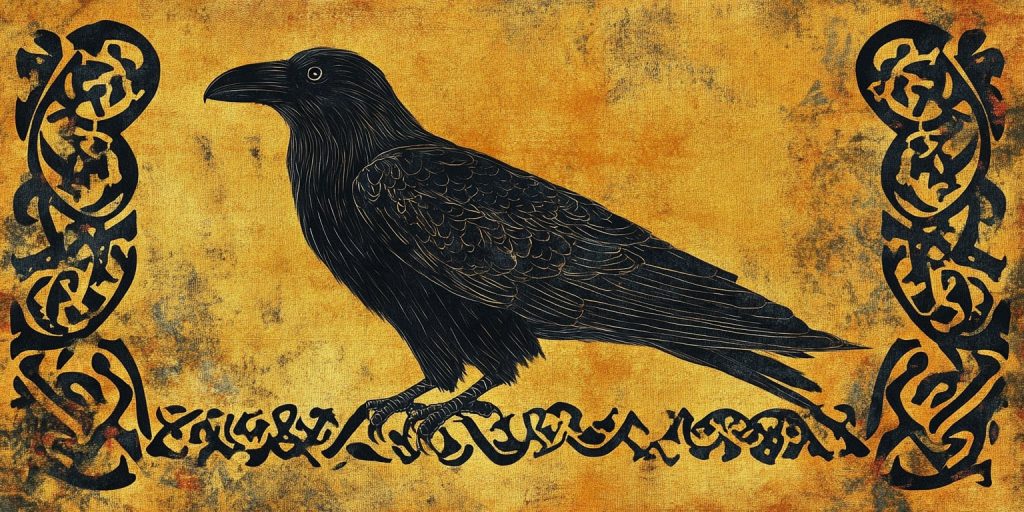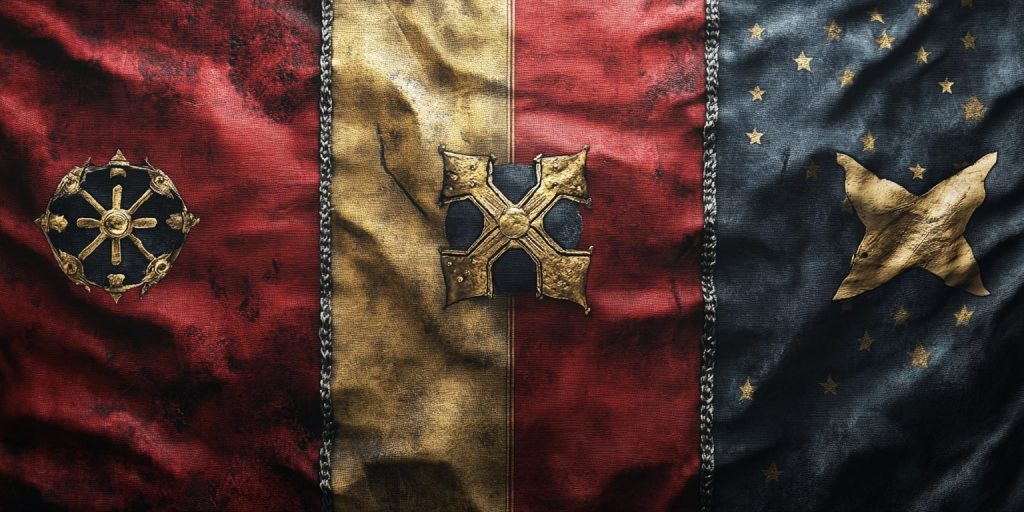Huginn and Muninn, Jörmungandr (Midgard Serpent or World Serpent), Norse Mythology, Norse Symbols, Odin, Vikings
Ravens, Serpents, and Hammers: The Iconography of Historical Viking Flags
Historical Viking flags were full of symbols and deep meaning. They were key to Norse culture. These flags showed who a clan or tribe was, what they believed in, and their values.
Animal symbols, such as ravens, serpents, and Thor’s hammer, were common on Viking flags. These symbols showed the Vikings’ strong connection to myths and spirits. Exploring these flags reveals the Vikings’ unique way of seeing the world. Each flag had a story to tell beyond just its design.
The Significance of Viking Banners in Norse Culture
Viking banners were more than just colors and designs. They were key identifiers in battles, boosting strength and unity. They also showed pride and belonging in communities.
The Role of Flags in Viking Society
Old Norse flags in Viking society were important for identity and memory. They were used in:
- Battle preparations, boosting courage.
- Ceremonies, showing clan loyalty.
- The display of historical flags often marked religious festivals seeking divine favor.
These banners inspired deep connections, linking people to their past and values, much like the stories in the Anglo-Saxon Chronicle.
Flags as Symbols of Identity and Beliefs
Every Viking banner was unique, showing clan, family, or achievements. These symbols represented their culture and beliefs. They could show:
- Lineage, with family emblems.
- Values, through design symbols.
- Religious beliefs with certain motifs.
Viking banners were more than physical objects. They were the heart of Norse culture, showing their values and relationships.
Understanding the Norse Raven Banner
The Norse raven banner is a key symbol in Viking history, often depicted in the Anglo-Saxon Chronicle. It links legendary stories with actual practices and is closely tied to Odin, the main god of the Norse pantheon.
It’s known for its striking design. The banner was used in battles for both practical and symbolic reasons.
Origins of the Raven Banner
The raven’s role in stories comes from Odin, who has two ravens named Huginn and Muninn. These birds represent thought and memory and show the bond between gods and humans.

In the Viking Age, the raven banner became a powerful symbol. Warriors thought it would bring Odin’s blessing. This would give them courage and protect them from enemies.
Symbolism of the Raven in Norse Mythology
Ravens play a big part in Viking myths. They symbolize knowledge, prophecy, and the path to the afterlife. In Norse culture, ravens are messengers between the human and divine worlds, often associated with the raven flag.
The sight of a raven was seen as a sign of big events. It guided souls and shared wisdom. This shows how much Vikings respected ravens, making the raven flag a lasting historical symbol.
Exploring Serpent Iconography in Viking Flags
Serpent images are key to understanding Viking flags, which often bore a raven as a symbol of their heritage. They show deep mythological beliefs, especially about serpents in Norse culture. These symbols are found in many flags, linking to chaos, change, and new beginnings, much like the tales of Harald.
The Mythological Importance of Serpents
In Norse myths, serpents mean a lot. They are tied to stories like Jörmungandr, the world serpent, showing life’s cycle, a theme echoed in Viking history. Serpents stand for danger and keep things safe, showing chaos and new starts. This mirrors the Vikings’ stories of survival and change, as told through the design of their raven flags.
![]()
Comparing Serpent Designs Across Nordic Regions
Looking into history, we see different serpent designs in the Nordics. Each place had its twist, based on local beliefs and culture. Here are some main differences:
- By the sea, serpents are mixed with sea symbols, showing a love for the ocean.
- On land, serpents are linked with forest themes, echoing earth myths.
- Colors and patterns vary, letting each region show its own style in Viking flags.
This look into serpent images shows how different cultures shaped Viking flags. It shows the serpents’ big role in their myths.
Historical Viking Flags: A Deep Dive
The study of Viking flags shows a world of design, purpose, and skill. There were battle flags, fleet flags, and ceremonial banners. Each had its look and colors, showing who it belonged to, often featuring the image of a raven flying.
Knowing about these flags helps us understand Viking culture and history better.
Different Types of Historical Viking Flags
Battle flags were bold, with detailed designs to show leadership. Fleet flags united ships with symbols of ownership and loyalty. Ceremonial banners showed status in rituals and celebrations.
These flags were more than decorations. They were symbols of unity, purpose, and identity.
Materials and Techniques Used in Flag Making
Viking flags were made from wool and linen, which was common in the Viking Age. They frequently featured the raven flag design. These materials were durable and good for dyeing, essential for creating vibrant historical flags. The flags used natural dyes and embroidery to show skill.
The making of these flags shows their importance in Viking culture. It shows the talent and history of the Norse people.
Final Thoughts
In conclusion, Viking flags were powerful symbols that carried the spirit, beliefs, and values of Norse society. Far beyond mere banners, they were emblems of identity, reflecting each clan’s connection to myths, gods, and heritage. These flags unified communities, represented lineages, and rallied warriors with bold symbols of ravens, serpents, and Thor’s hammer. Each element within these flags, whether the raven for wisdom and courage or the serpent symbolizing transformation, told stories that linked the Vikings to their ancestors, gods, and the natural world.
Examining these flags’ materials, colors, and craftsmanship reveals a deep dedication to preserving and celebrating their Norse heritage. Historical Viking flags’ intricate designs and profound meanings provide a vivid window into Norse beliefs and values. They remind us of a society that revered its myths and heritage. They use these powerful emblems as lasting tributes to their worldview, unbreakable unity, and the courage that defined the Viking Age.

